Artificial Intelligence and Photography: a Bright or Dark Future?
Let’s face it, complaining about Artificial Intelligence and Photography is about as effective as a typewriter salesperson trying to stop the rise of computers. AI is here, and it’s here to stay.
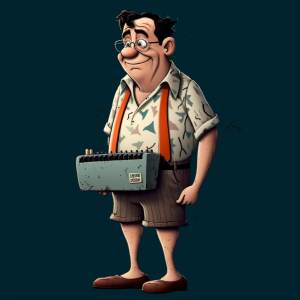
Greatest AI Advancements (yet)
After OpenAI amazed us with Sora, it is teasing us with a sound generator that can learn from mere seconds of any voice, Anthropic’s Claude outruns ChatGPT 4… The AI News storm seems to never lose its power.
Among those ever-flowing overwhelming news streams, I must confess I was very impressed after reading about the newest and most recent MidJourney version 6 (MJ6), I had to experiment myself and found that it is indeed incredible. The images can look and feel absurdly realistic! Gone are the days of 8-fingered hands and easy-to-spot AI signals. Even text comes properly written and rendered. It is so easy to get lost playing creating random images with the justification that I wanted to test this incredible marvel. This is one comprehensive blog post that compares MidJourney v6 to the nearest contenders with plenty of images for you to evaluate for yourself.
Even though I don’t always agree with John’s picks and the “there’s room for everyone to win” table in the end, we agree that MJ6 is the undisputed king of the hill. At least until the competent folks at Stable Diffusion release their much-anticipated version 3, let’s see. And if you are curious, there are plenty of MJ free alternatives here and here, even though they have a lot of ground to catch up with the king.
In a way, we are not far from the online discussion we had in 2023, when we spoke about AI x Creatives, and had the pleasure of seeing Dr. Selman Bozkir teach us the insides of AI.
Photography: Evolve or Die Complaining
The photography industry as a whole was already deeply impacted by another “pro photographer killer”, the menacing TFP Photographer. The immense popularization of competent cameras and the ubiquity of free knowledge turned the average camera owner into a potential alternative to the formally established camera master. Such changes are felt and seen in almost every photography area, from portraits to events. I cannot count how many times I have seen people asking for amateur photographers to cover weddings! And plenty of TFP photogs are happy to jump in and work to improve her/his techniques, develop their portfolio or even show off on social media. This trend is met by the “customers” reducing the quality threshold to pay less and potentially because most photos will be lost among the billions of photos profusely proliferating on every available screen.
And then that popularized and changed industry met AI and the real question isn’t whether AI will impact photography, but how it will impact it. Photography, from the artistic to the commercial, is on the verge of a major transformation thanks to AI. While some fear AI replacing photographers entirely, the reality is more nuanced. It’s more likely that “typewriter photographers” who refuse to adapt will be replaced by those who embrace AI. Think of it as a natural evolution – photographers who leverage AI will create a whole new level of amazing work.
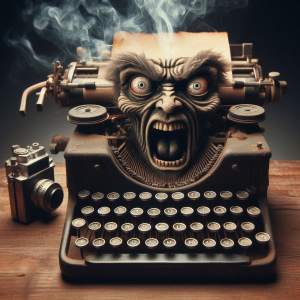
There is a bright and shiny side to the dystopian fears around Artificial Intelligence and Photography. AI’s tremendous impact is clear in the waves of edited photos and videos that flood social media. As it became AI-tomatic to remove distractions, edit to the beat of a song, combine clips, and much more, photo and video posts increased AI-fold. Everyone with a smartphone can easily do it, the days of needing a 30.000 dollars MacPro workstation to render a video are (thankfully) gone. I remember waiting over 40 hours to generate 1080p videos in the not-so-distant past.
Fear of Democracy Anyone?
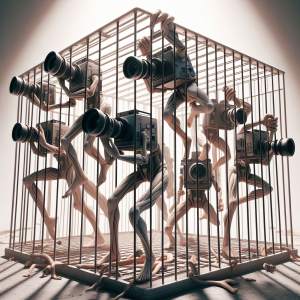
Just like Napster and Spotify forever changed the music industry, AI is poised to do the same to photography.
In my humble opinion, AI democratizes photography. As it happened when digital cameras became popular, the entrance barriers decreased drastically, meaning most “lay people” could become photographers without needing to undergo years of training and investing heavily in equipment. To rub salt in the flesh wound, mobile photography followed, and the barriers went even lower (sometimes bringing expectations and quality levels with it 🤭). Now AI is obliterating most remaining barriers, including post-production. Everyone can be the next big shot in photography, even without knowing the basics about post-production. Seriously, even without a camera!
But this disruption isn’t all bad news, and it doesn’t mean artistic vision should go out the window. As AI releases our resources, it frees everyone to focus on the creative aspects of photography, regardless of technical expertise. The result? Anyone can become an image-maker, and the potential for truly groundbreaking visual storytelling is wide open.
Artificial Intelligence and Photography: Threats – Time to Adapt
Let’s be honest, AI does pose some challenges. Tasks like basic editing and noise reduction could become automated, potentially impacting photographers who rely heavily on these services.
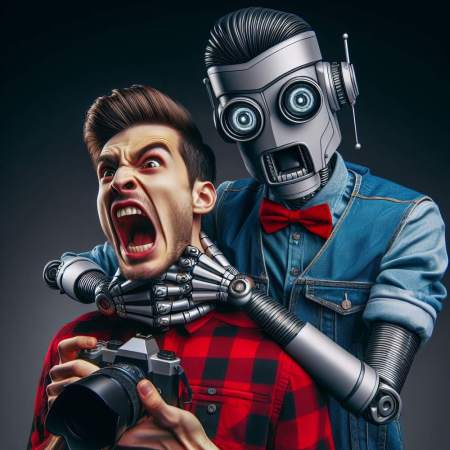
Some of the potential typewriters of the future:
- Automated Culling and Editing: AI algorithms can now enhance and retouch photos with remarkable precision, from portraits to landscapes and everything in between. While this streamlines post-processing, it also means that editors who rely solely on selling such services may soon find themselves obsolete.
- Stock Photography: As the outputs improve fast and drastically, AI-generated stock photos are becoming more common. These images are often multiple times cheaper and almost instantly available, posing a challenge to photographers who depend on stock photo sales. Honestly, except for some niche opportunities, these dinosaurs can already see the comet.
- Product Photography: at its peak, product photography needs time, a big team, oodles of preparation, and perfection before and after the shot. As an example, competent and formally trained food stylists specialize in sourcing ingredients and crafting a scene to the utmost perfection. Then come a photography crew with countless lights and uncountable hours of training and elaborate a complex light system so the clients’ briefing is considered. Then the agent keeps in touch with the client during the many stages of editing/delivery to make sure the post-processing of the whole day of shooting renders the images as envisioned. And it can challenge even deep pockets. I don’t believe product photography will die, but I can easily see AI 3D-rendering a mock-up product, thrown in the AI blender (pun intended) and coming out as a perfect, near-instant image for a fraction of the cost.
- Video is not safe: as recently seen with OpenAI’s Sora, this front is quickly developing from very poor results to impressive – although still very far from good – prompt-to-video performance. The competition is still even further away but certainly coming, like the contender Haiper AI.
- Not even the tip of the iceberg: a lot is still to come, and I don’t mean the infamous General Artificial Intelligence. What are your thoughts? What do you think is still to come?
One of the greatest risks I see is AI Standardization. AI tools are the new hot trend and, we humans like to flock towards the shining light of the new. While AI can make life much easier by analysing what is in front of the camera and suggesting optimal settings and compositions, it might lead to a homogenization of visual styles if everyone follows the same AI-driven guidelines. And the more we follow, the more AI will cater those kinds of images to our feeds and the loop downwards will keep accelerating towards the bottom.
Artificial Intelligence and Photography: Opportunities – Embrace the Future
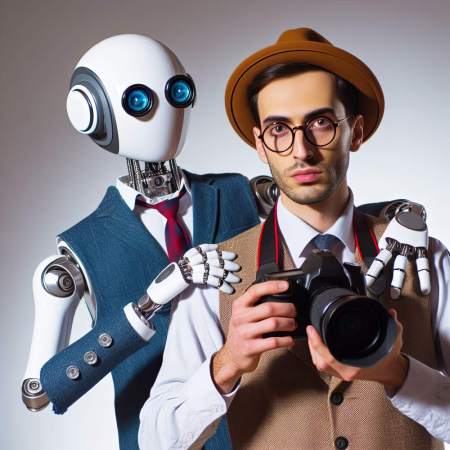
But here’s the exciting part: AI can be a powerful tool for photographers. Imagine AI-powered autofocus that never misses a shot (which is already almost here), or software that suggests creative awe-inspiring compositions in real-time. I can easily imagine ChatGPT’s little brother inhabiting a camera and receiving audio requests from the photographer, who tells the camera what his wishes are. Then AI comes to the rescue and can free photographers to focus on the artistic aspects of the craft, like capturing emotion and telling stories (instead of being frustrated and fiddling with buttons and levers to no avail).
What else?
- Workflow Efficiency: AI can handle repetitive tasks, such as sorting and tagging images, leaving photographers with more time to focus on creativity. It can even learn a photographer’s style and apply it to AI-selected photos, much as we use presets nowadays.
- Grass is always greener: the upcoming changes may facilitate things and allow photographers to venture into territories they have no experience in. A fashion photographer could have an easier time jumping into product photography or stock photography (if they have a strong wish to be extinct even sooner).
- Predictive Analytics: AI can analyse trends and predict popular photography styles, helping photographers tailor their work to market demands.
- AI-Resistant: some die-hard niches will probably resist the AI revolution and endure. Think of events, maternity photos, weddings, and all situations that carry this kind of uniqueness with them. Regardless of how much AI advances, an actual well-produced photo/video of the wedding party is not easily replaced by AI. Such niches might even survive this revolution if they can survive another menace: TFP photographers and the ever-growing “there’s someone that will do it for free”.
Resistance is Futile
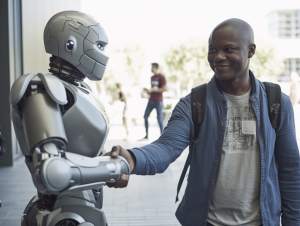
AI is here, and it’s not going anywhere but forward.
Keeping it real with the fears surrounding Artificial Intelligence and Photography, many activities will become cheap and easy, and some will even be overtaken by “the machines” with the click of a button.
Rather than resisting, let’s embrace it, learn how to use it effectively, and use the extra momentum to push the creative boundaries unrestrained. Learn how to co-inhabit this new world, explore its possibilities, and maximize AI’s incredible potential. After all, unless Skynet is already online, the future belongs to those who evolve alongside the machines!







